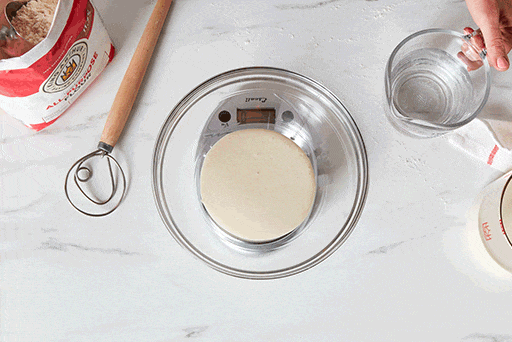Instructions
Prevent your screen from going dark as you follow along.
-
To store your starter at room temperature: Stir the starter thoroughly. Spoon 1/2 cup (113g) starter into a bowl; either discard the remaining starter or use it in another recipe (see "tips," below). Add 1 scant cup (113g) flour and 1/2 cup (113g) lukewarm water to the 1/2 cup (113g) starter in the bowl. Mix until smooth, return to its jar or crock, and cover.
See AlsoHow To Get Bigger Bubbles In Your Sourdough StarterSigns that your sourdough starter is ready to bake withLearn How to Make Great Sourdough
-
Repeat this process every 12 hours, feeding the starter twice a day. Remove starter to bake with as soon as it's expanded and bubbly, then feed the remaining starter immediately; revert to your normal 12-hour schedule for subsequent feedings.

-
To store your starter in the refrigerator:Take the starter out of the fridge; there may be a bit of liquid on top. Either drain this off or stir it in, your choice; it's simply a byproduct of the fermenting yeast.

-
Spoon 1/2 cup (113g) starter into a bowl; either discard the remaining starter, or use it in another recipe (see "tips," below). Add1 scant cup (113g) flour and 1/2 cup (113g) lukewarm waterto the 1/2 cup (113g) starter in the bowl. Mix until smooth and cover.
-
Allow the starter to rest at room temperature (about 70°F) for at least 2 hours; this gives the yeast a chance to warm up and get feeding.After about 2 hours, replace the starter in its storage container and refrigerate.

-
To maintain your starter's health (and for best baking results), repeat this process about once a week.
-
To ready your refrigerated starter for baking: Take the starter out of the fridge, discard (or set aside) all but 1/2 cup (113g) and feed that 113g as usual with equal parts (113g each) flour and water. Cover the starter and let it restat room temperature. Depending on its health and how recently you'd fed it, it will start to bubble and expand quickly, or may take up to 12 hours to show signs of life.

-
Feed the starter every 12 hours until you see it double or triple in volume within 6 to 8 hours; this means it's ready to bake with.
-
For what you judge will be thefinal feeding prior to baking, add enough flour and water to use in your recipe, with 1/2 cup (113g) left over to feed and maintain the starter for the next time you bake. For instance, if your recipe calls for 1 cup (227g) starter, add 113g each water and flour. If your recipe calls for 2 cups (454g) starter, add227geach water and flour.

-
Once the starter is "ripe" (ready to use), spoon out what you need for the recipe and set it aside with the recipe's other ingredients. Feed the remaining 1/2 cup (113g) starter as usual, with equal parts (113g each) flour and water. Mix until smooth andlet the starter rest for about 2 hours at room temperature before stowing it back in the refrigerator.

Tips from our Bakers
Use "discard" starter to make pancakes, waffles, cake, pizza, flatbread, or another treat; for inspiration, see our sourdough discard recipe collection.
Sourdough baking is as much art as science. This method for maintaining sourdough starter is just one of many you might choose to follow. It may not match what's writtenin your favoritesourdough cookbook, or what's shown in that video you saw online.And that's OK: If you have a process you successfully follow regularly, then stick with it. Or try this one and compare. All good.
Looking for tips, techniques, and all kinds of great information about sourdough baking? Find what you need in our sourdough baking guide.






